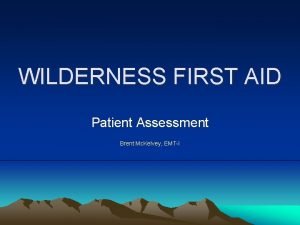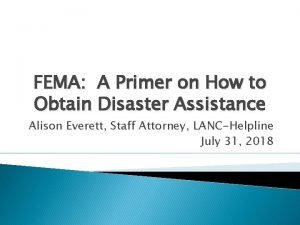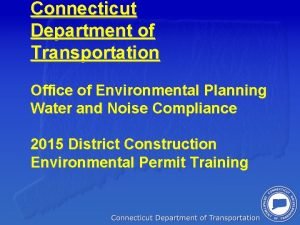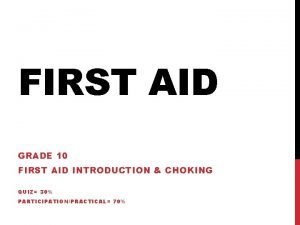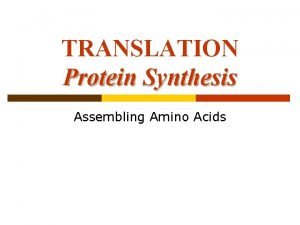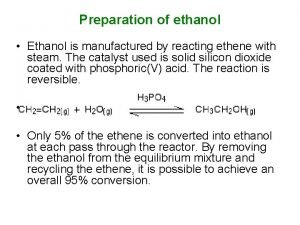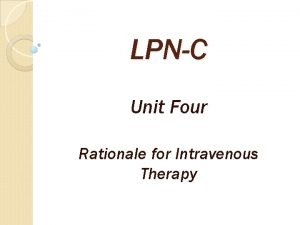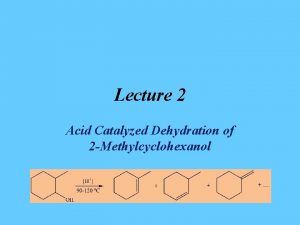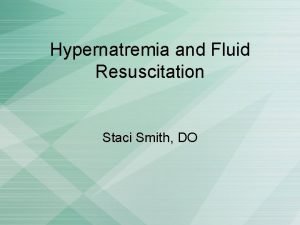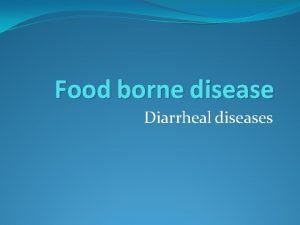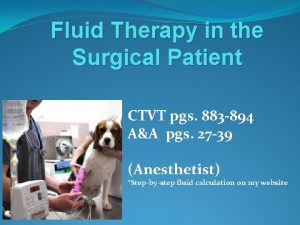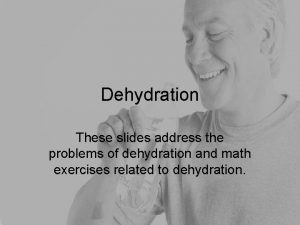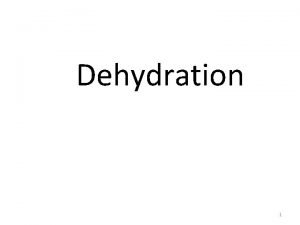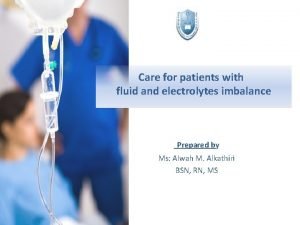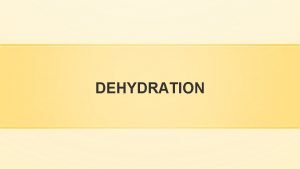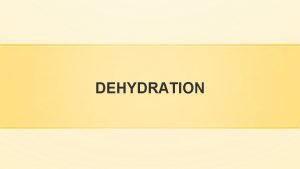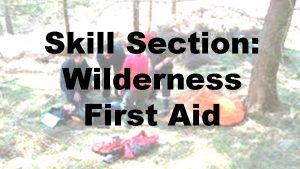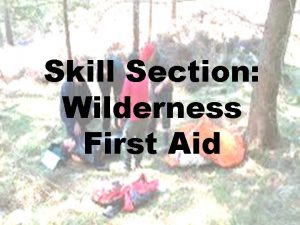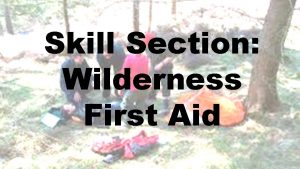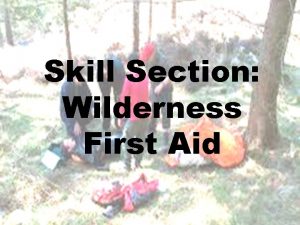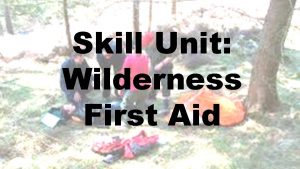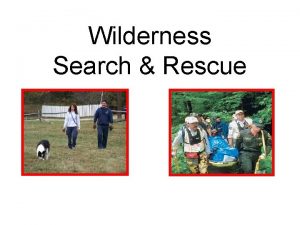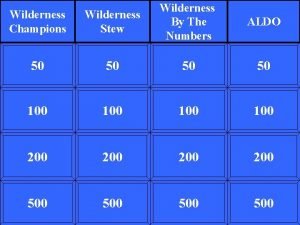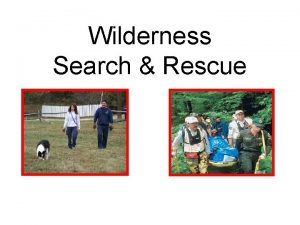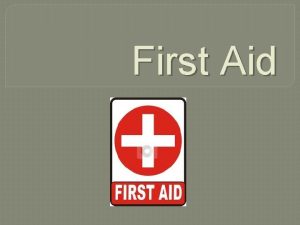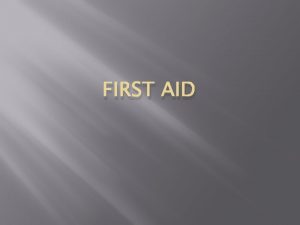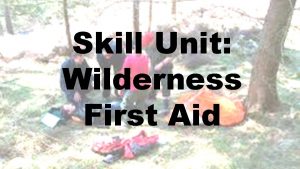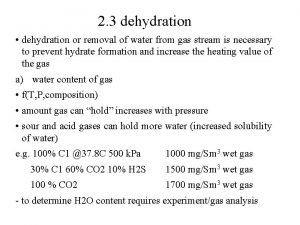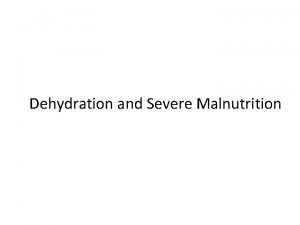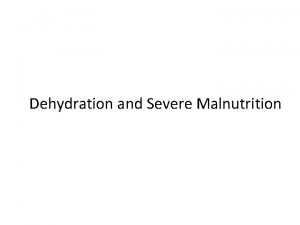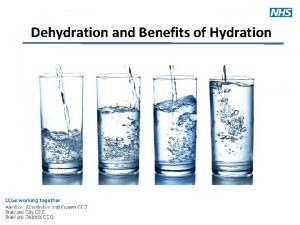Skill Section Wilderness First Aid Skill 817 Dehydration






















- Slides: 22

Skill Section: Wilderness First Aid

Skill 8/17: Dehydration & Heat Illness

Learning Intention: To equip you with the knowledge to avoid and treat heat illnesses.

Success Criteria: By the end of this session everyone should be able to: • Describe what steps to take to avoid, recognise and treat heat-related illnesses when walking.

Activities: 1. Discussion/Powerpoint: - What is a heat illness? - What can you do to avoid them? - How should you treat them? 2. Scenario

What is a heat illness?

Heat Illnesses (“Hyperthermia”) Severity v Heat rash v Sunburn v Heat cramps v Heat exhaustion v Heat stroke American Meteorological Society Central North Carolina Chapter April 21, 2005

Heat Rash (prickly heat) Symptoms: Skin becomes reddened and may itch, feel prickly or hurt. First Aid: Practice good personal hygiene; keep the skin clean and the pores unclogged, allow skin to dry, wear loose clothing.

Sunburn Symptoms: Skin becomes reddened, pain, blistering in severe cases. First Aid: Move into shade or cover minor burns with light cloth, frequent sips of water, cool skin by sponging with water, apply after-sun.

Heat Cramps: Symptoms: Cramping of either active muscles (arms, legs) or involuntary (usually abdominal) muscles (or both). First Aid: Replenish electrolytes through drinking of fluids such as sports drinks etc. Rest in a cool environment.

Heat Exhaustion: Symptoms: Nausea, dizziness, weakness headache, blurred vision, profuse sweating, cold/wet (clammy) grayish skin, unconsciousness, coma and death. First Aid: Lie down in a cool location, administer fluids if conscious. If unconscious, seek medical care.

Heat Stroke: Symptoms: Chills, restlessness, irritability, euphoria, red face and skin, disorientation, hot/dry skin (not always), collapse, unconsciousness, convulsions and death. First Aid: Immediate, aggressive cooling of the victim’s body using wet cloths, immersion into cold water or alcohol wipes. Contact emergency services ASAP!

Avoidance

v Sun-hat and or sun-screen v Remove clothing layers v Stop & rest v Move into shade v Drink little & often to avoid dehydration

Dehydration fluid loss time* effect & symptoms (* timing may vary based on intensity of exercise and heat/humidity) 0. 75 L 1 hr 1. 5 L 2 -3 hrs loss of endurance, start to feel thirsty, feel hot, uncomfortable 2. 25 L 3 -4 hrs loss of strength, loss of energy, moderate discomfort 3 L 3. 5 -4 L 5+ L 4 -5 hrs 5 -6 hrs 7+ hrs cramps, headaches, extreme discomfort unnoticed (at 1. 5% weight loss you are considered dehydrated) heat exhaustion, nausea, faint heat stroke, collapse, unconsciousness taken from: OH&S Canada Volume 69, Number 5, page 52, May 2000

What to drink: • Water is the best; juices are also good (juices contain energy restoring glucose). • Electrolyte (sports) drinks (e. g. Powerade) are usually not needed (but can be used for first aid for cramps). • Stay away from caffeinated carbonated, diet drinks and alcohol as they take water out of your body.

How Much Water is Enough? • More than you want just to satisfy your thirst • Sources of water are: 1. Fluids – ½ pint = 250 m. L every 30 -60 min 2. Foods - fruit & veggies are 90% water • Not too cold

Eat Healthily You can and should replace essential elements lost during sweating; Eat a balanced diet rather than taking salt tablets or drinking expensive sports drinks.

Watch out for each other! • Someone heading into a heat stroke will no longer realise what is happening to him/her • It is vital that group members be able to recognise what is happening and intervene • Without quick attention, the person may die!

Treatment

General advice: v Lie down in shade v Sip water v Remove outer clothing v Cool with damp cloth, especially head & neck

Questions?
 First aid patient assessment form
First aid patient assessment form First aid merit badge first aid kit
First aid merit badge first aid kit Single premium endowment plan 817
Single premium endowment plan 817 1-817-868-2300
1-817-868-2300 Ct dot form 817
Ct dot form 817 Sprat qrp
Sprat qrp Day 1 day 2 day 817
Day 1 day 2 day 817 Objective of first aid
Objective of first aid Neasden and greenhill medical centre
Neasden and greenhill medical centre What is skill
What is skill Amino acid structure
Amino acid structure Neopentyl alcohol dehydration
Neopentyl alcohol dehydration Dehydration urine specific gravity
Dehydration urine specific gravity Acid catalyzed dehydration of 2-methylcyclohexanol
Acid catalyzed dehydration of 2-methylcyclohexanol Types of iv fluid
Types of iv fluid Sodium deficit
Sodium deficit Cholera
Cholera Crystalloid solution example
Crystalloid solution example Types of dehydration
Types of dehydration Mild moderate severe dehydration
Mild moderate severe dehydration Mild moderate severe dehydration
Mild moderate severe dehydration Saytzeff rule
Saytzeff rule Transportec
Transportec
